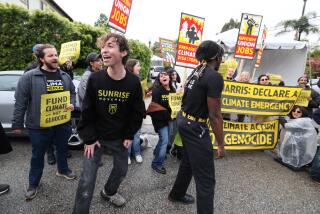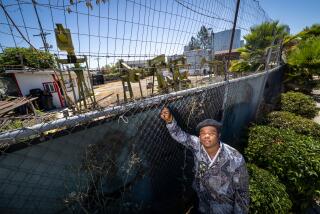At Peace With Themselves
It was 1986. As the United States and the Soviet Union waged the Cold War, those fearful that the superpowers were going to blow each other up were demanding, “No Nukes!” On March 1, a determined band set out from Los Angeles on a 3,300-mile march to Washington. The goal: to create a groundswell of support for global nuclear disarmament.
It didn’t quite work out that way. A decade later, there is no comprehensive test-ban treaty. But the Soviet Union is gone and, with it, the specter of nuclear immolation.
And, on March 1, survivors of the 8 1/2-month Great Peace March will mark the 10th anniversary at a noon ceremony on the west steps of City Hall.
About 400 hardy souls made the whole trek. Some, like Jerry Rubin, 52, of Santa Monica, are still fighting for the cause. Last month, he was arrested for trespassing outside the Chinese consulate while protesting nuclear weapons testing.
Others have moved on to other issues, to marriage, careers, children. Not all agree on what the march accomplished, but they do agree that it was a seminal event in their lives.
“For some, it’s been the totality of their life,” says Joe Broido, 65, of Santa Monica. “They never got beyond it.” For him, it was “the experience of a lifetime, for a cause that was noble. It was a safe midlife challenge, physically terribly demanding, but the natives spoke your language and your plastic was good anywhere.”
He laughs. “I went thinking I was going to be a spear carrier in a wonderful moving Italian opera.” He wound up one of a ragtag group, living from hand-to-mouth, dependent largely on the kindness of strangers in towns and cities across America’s heartland.
The Great Peace March was conceived by David Mixner, a longtime activist and founder of PRO-Peace (People Reaching Out for Peace). He envisioned 5,000 marchers, well funded and with a convoy of high-tech support vehicles, who would wow the media and spark a movement of millions worldwide. The reality was 1,200 marchers, many of whom would turn back--and media reports of a flop.
The $20 million he hoped for from corporate sponsorships, films and merchandising tie-ins never materialized; about $4 million was raised, $700,000 of it by the marchers themselves from dollar-a-mile pledges. Instead of a star-studded send-off before 100,000 at the Coliseum, there was a modest City Hall rally that drew about 6,000, including hecklers.
In Barstow, 10 days later, a debt-plagued PRO-Peace dropped out and the marchers regrouped as the Great Peace March for Nuclear Disarmament, ill-equipped and largely winging it, a traveling tent city of citizens from 9 months to 79 years old. Among them were the young and angry and aging liberals who’d missed out on the civil rights marches of the ‘60s. Kathleen Hendrix, covering the march for The Times, described it as “a band of shepherds looking for a flock.”
“We only agreed on one thing--global nuclear disarmament,” says Mim Broderick, 77, of Studio City. Another marcher put it this way at the time: “We can’t agree on anything, except to knock at the Porta Potti.”
*
Still, a bond was being forged that was powerful enough to see the participants through. Madonna Newburg, 66, of Manhattan Beach, says, “We felt that we could change the world--and we really have, because we changed ourselves.”
Mary Jane Jones, 68, of Mount Washington, had always thought of herself as powerless to create change. When she refinanced her house and took a leave of absence from her county job to go, “People said, ‘Oh, you’re so brave.’ What I always knew inside was that I was saving myself.”
Strangers became family, a family that holds huggy, teary annual reunions, recalling the good war. They laugh about quickly weeding out those who thought the march was Club Med, such as the woman who wailed, “But where am I going to plug in my hair dryer?”
They remember the black church in Toledo, Ohio, a target of violent acts by white neighbors. There, they linked hands with the congregation and sang, “We Shall Overcome.” They remember their exhilaration on reaching the crest of the 12,000-foot Loveland Pass in Colorado, knowing that from then on it was, as they liked to say, “all downhill.”
They remember hot showers and hot meals in friendly homes. Children rushing out, bouquets in hand. Trains whistling in salute. Junk food forays. The trucker who gave the marchers watermelons. The nights sleeping in farmers’ fields among the corn and the cows.
Rubin, who’s often confused with the late “yippie” founder and ‘60s peace activist Jerry Rubin, recalls the marchers being invited to Kent State University in Ohio until “someone in the administration got wind that ‘Jerry Rubin’ was going to speak and they said, ‘When he was here last time, he talked about people killing their parents.’ ”
The marchers did speak at Kent State and, while there, lit candles at a monument to the four students killed by National Guardsmen during a 1970 antiwar protest. The candles were ignited from a flame lit at the peace monument in Hiroshima and carried along the march.
Some called the marchers Commies. In Toledo, Jones recalls, “a young man in a beautiful three-piece suit spat at me.” They also endured searing heat, biting cold, exhaustion. “The marchers became survivors,” says Billy Lieb, 72, a Santa Monica artist. “There’s not much that can rattle us now.”
Of the group, about 20 “no longer march with us,” as Broderick puts it. Among them are Liz Marek, who perished in the 1988 bombing of Pan Am Flight 103 over Lockerbie, Scotland, and Franklin Folsom of Denver, the oldest marcher, who died recently at 89.
*
Romance, it appears, was rampant on the march. At least 23 couples who met then have wed. Most of those marriages are intact and about 40 Great Peace March children have been born. To Broderick, that’s cause for optimism. “You know, there were a lot of marchers who said they were never going to have children” in a world threatened by nuclear devastation.
Did the Great Peace March make a difference? Most marchers tend to speak in terms of lives changed rather than global change. But Rubin, for one, says, “In a small way this helped lead to some of the first arms-control agreements.”
Did it make a difference? Says Jones: “It was an awfully thin line we took across the United States. Yes, on that line, for those who saw us and heard us.”
Ann Edelman, 72, of Laurel Canyon, and her husband, Dick, a physician, made the march and, together with Broderick and Lieb, were among those who marched from Leningrad to Moscow the next year with Soviet peace activists. Once home, she says, “I swore I would never go to another rally.” But the march, she says, “made me much more accepting, less critical. We had young anarchists, people on the fringes. It was very different from my middle-class milieu.”
Lieb, too, believes that the marchers--an estimated 3,000 who joined at some point en route to a triumphant gathering at the Lincoln Memorial where the march ended in November--made an impact along their route. “It started peace marches all over the world.”
Mixner, 49, who started it all--but did not make the trek--will skip the March 1 commemoration. While he remains persona non grata to some marchers, others have forgiven and forgotten. “I had the vision, but I let a lot of marchers down,” Mixner says. “The real story starts from Barstow when, very courageously and on their own, they made it across the country.”
Says Broderick, a forgiver: “We all became better people through adversity. I think the march we had was the march we needed to have.”
* This weekly column chronicles the people and small moments that define life in Southern California. Reader suggestions are welcome.
More to Read
Sign up for Essential California
The most important California stories and recommendations in your inbox every morning.
You may occasionally receive promotional content from the Los Angeles Times.










